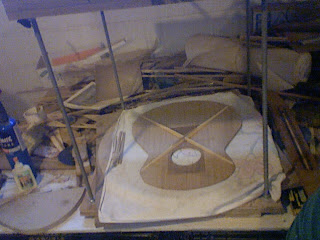First, I've been slow posting this past week because Tuesday (1/16/07) was the first day of class this semester. Moreover, my office was moved during winter break, and so I've been wrestling with boxes and networking in addition to the usual demands of new students.

As per previous post, binding and purfling ledges were routed. I went ahead and took care of the non-cutaway side, as it's a tad easier to bind.
Part of my reason for blogging my building is to be honest about this process. Neither am I god's gift to lutherie, nor am I without skill. I changed the name of this blog because the old title made me sound too incapable, too pathetic. I am neither. But, I have to work at this, and some times it is a struggle. The only way to improve skills is to try and fail and try some more. Now, I don't think I've failed -- far from it! But I've had to follow the "two steps forward, one step back" method as well.
Do I have the courage to say all this in a public forum? Is it not wiser (from a marketing viewpoint) to allow those folks for whom I build guitars to nurture an image of a master artisan whose every move leads to a predictable and calculated outcome? Perhaps it is. But that doesn't feel right to me. I do know what I'm doing. Still there are surprises along the way. Not all surprises are welcome. Some turn out in a way not intended. So, I have to go back and fix things. I am and will always be learning. I cannot believe this is not also true of every instrument builder, even Charles Fox, Kevin Ryan and Jeffrey Elliot. I bet Torres had to fix a few of his own mistakes now and then.
To my mind there is no shame in producing by hand an instrument which does not display the cosmetic perfection of a factory instrument. If you can tell it's hand made, that's no tragedy. It's an instrument -- a vehicle -- for the making of music. If it has an interesting voice that speaks to the musician and that musician's listeners, if it's playable and allows the musician to try new ways of playing, or to write new songs, or if it inspires a new musician to learn to play and brings the satisfaction of participating in acts of music-making, then it is a complete success. Cosmetics be damned.
That being said, I try hard to make 'em as pretty as I can. Each guitar is better than the last, and I work steadily to make that trend continue.
I'm using thin b/w purfling on the top, back and sides, as well as fine herringbone on the top. The idea is easy, but with bindings, two fine purfling strips and herringbone on top, coupled with the fact that you install the back bits and top bits per side simultaneously, it's not hard to end up with a gluey mess. It's also possible for the fine purflings to become misaligned. When they do, you have to yank it all apart, douse it with water, realign and re-clamp. Ugh!

Clamping, as you can see, is done with this mediaeval device, rope and wedges. Oh, yeah, it also helps to do it all before the power failure hits (as it did this morning, hence the mag-light illumination). Fortunately, I had everything in place and most of the ropes on. You can see that I'm clamping the binding/purfling around the lower bout, and that the upper bout remains on the "to-do" list.
Already the voice is changing quite a bit. I indicated in a previous post that the sound of the box is changed completely by the binding. At the halfway point already there was more sustain and a clearer, deeper tonal response from a fleshy-thummed thump.












